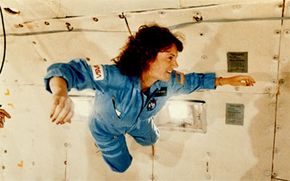New Types of Astronaunts
Over time, NASA missions evolved and so, too, did the qualifications for becoming an astronaut. By 1964, emphasis had shifted away from flight experience and toward superior academic achievement. The first scientist-astronauts joined the program in 1965 to deepen knowledge of geology, astronomy, physics and biochemistry. This new breed of astronaut, however, was expected to endure the same rigors of training and to become proficient in spacecraft operations. The first five scientist-astronauts were Joe Kerwin, Curt Michel, Owen Garriott, Ed Gibson and Jack Schmitt.
Today, NASA selects two kinds of astronauts for space flights -- pilot astronauts and mission specialist astronauts. Pilot astronauts command and pilot spacecraft and could command, in the near future, vessels that travel to Mars or back to the moon. Mission specialist astronauts work with pilots to maintain spacecraft and equipment, conduct experiments and launch satellites. Mission specialists may be engineers, scientists or physicians. NASA has also introduced mission specialist educator astronauts. Educator astronauts go through the same training as any other astronaut and, by traveling into space, inspire students to join the U.S. space program or to consider careers in math, science, engineering and technology.
Advertisement
There are two kinds of astronauts that fall outside NASA's standard recruitment procedures. International astronauts are those individuals from international space agencies who have trained at Johnson Space Center and serve as mission specialists. International astronauts come from four agencies that have an agreement with NASA: the European Space Agency (ESA), the Japan Aerospace Exploration Agency (JAXA), the Brazilian Space Agency (AEB) and the Canadian Space Agency (CSA). Payload specialists are scientists who work for the owner of the payload (usually a private company or university) and carry out experiments involving the payload. As such, they are not NASA employees, but NASA must approve their appointment.
Both civilian and military personnel can apply to become what NASA calls astronaut candidates. All astronaut candidates must be U.S. citizens and must have bachelor's degrees from accredited institutions in engineering, biological science, physical science or mathematics. All candidates must also be able to pass the NASA long-duration space flight physical, which has minimum requirements for visual acuity, blood pressure and standing height. Other requirements are based on the astronaut position, as outlined below:
- Non-pilot candidates must have at least three years of related, progressively responsible, professional experience. An advanced degree is desirable and may be substituted for experience (a master's degree equals one year of experience, a doctoral degree equals three years of experience). Teaching experience, including experience at the K-12 levels, is considered to be qualifying experience for the astronaut candidate position.
- An advanced degree is also desirable for pilot candidates. More importantly, pilot candidates must have at least 1,000 hours pilot-in-command time in jet aircraft. Flight test experience is highly desirable.
Anyone interested in becoming an astronaut candidate must submit an appropriate application. Applications are screened, and those under consideration are invited to a weeklong process of personal interviews, medical screening and orientation. Selected applicants are assigned to the Astronaut Office at the Johnson Space Center in Houston, Texas, where training is held.
Once someone is selected to go into space, they have to get ready. How does NASA prepare its candidates for duty?
